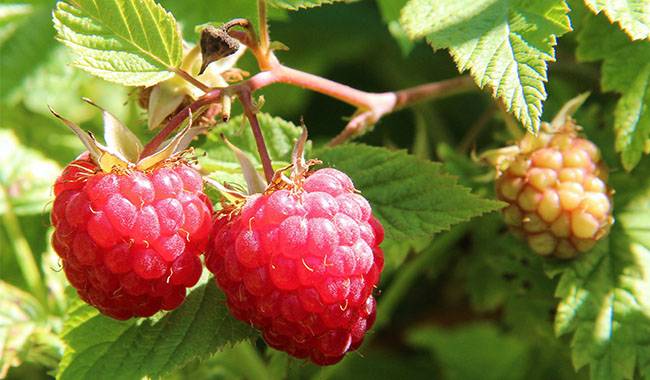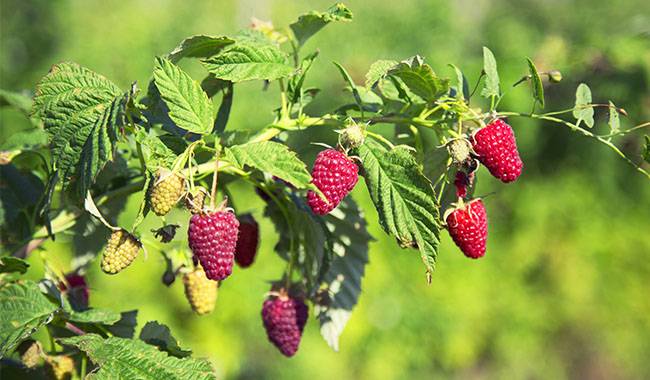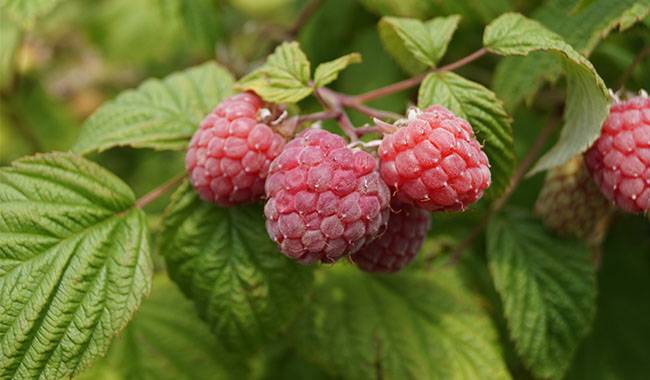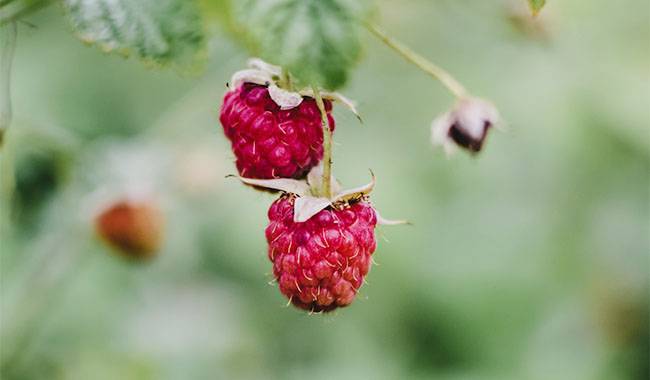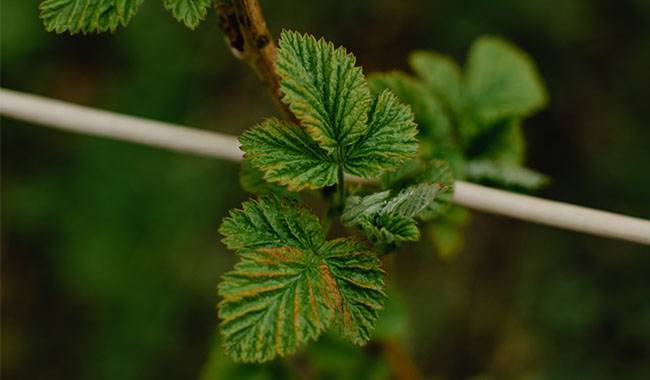
The classic Raspberry fertilization program is a combination of mineral and organic fertilizers. The first of these is done primarily in the spring at a rate of 10 grams of ammonium nitrate or 7-8 grams of urea per 11 square feet, and the second in the fall in the form of ash (100 grams per 11 square feet), peat (8.8 Lb per 11 square feet), compost (from 5.5 Lb per 11 square feet), or manure (5 buckets per 11 square feet).
However, despite all efforts, the appearance of Raspberry beds often calls into question their satisfactory condition, and the question arises: What nutrients are the Raspberry lacking as its raspberry leaves turning yellow? There are two ways to answer this question: through a laboratory examination of the soil and foliage and a visual assessment of the condition of the bush. The latter will be dealt with.
WHY ARE THERE NUTRIENT DEFICIENCIES?
A lack of nutrients in a Raspberry plantation is not always an indication of poor maintenance. Weather conditions are often the cause of the problem.
For example, excessive rainfall in early and mid-summer can wash nutrients from the soil surface, denying them to the roots of the berries. Then Raspberries begin to suffer from nitrogen and potassium deficiencies.
Gardeners are no strangers to the opposite situation – prolonged periods without rain. During such periods, it is very important to control soil moisture under the Raspberry tree by watering. Without such control, the lack of moisture can hinder the plant’s nutrient supply and, therefore, the Raspberry will suffer.
Stagnant moisture in the root zone can also be very dangerous. It leads to poor aeration and can cause the death of individual Raspberry bushes and entire Raspberry trees.
Poor overwintering behavior also affects the plant.
Let’s look at those or other reasons for deviations from the norm that may occur during the development of a Raspberry.
THE UNEVEN DEVELOPMENT OF RASPBERRY LEAF APPARATUS
Uneven leaf organ development observed on Raspberry in spring, i.e., after buds have awakened, indicates that shoot tissue has been damaged by frost. In full sun, the leaves of this plant will wilt, and the crown will droop.
What can I do? Foliar treatment with a 0.2% solution of monopotassium phosphate supplemented with urea will help.
RASPBERRY IS SLOW-GROWING
The slow growth of Raspberry may also indicate a nitrogen deficiency. Small, thin leaves, light green leaf litter, and weak, easily bent young shoots are other signs that this assumption is correct.
In this case, however, poor external development of the plant is not the main problem for the berries. In areas where there is a lack of nitrogen, the buds of the culture will be considerably reduced, and the productivity of photosynthesis will be lower.
What to do? Fertilize with the full amount of nitrogen fertilizer.
RASPBERRY SHOOT OVERGROWTH
Too much growth of young shoots signals an excess of nitrogen. It also has a significant impact on yield: more water in the berries and less color, aroma, and flavor. In addition, elongated shoots shade the bush, creating high humidity inside it and promoting the development of fungal diseases. Moreover, such plantings do not ripen in time for winter and therefore suffer from frosts.
What can you do in this case? Nitrogen fertilizer should be reduced by half (no more than 3 grams per 11 square feet) or replaced by a foliar spray of 1% urea before and after flowering.
RASPBERRY’S UNUSUAL DARK FOLIAGE COLOR
Atypical dark foliage coupled with (or without) slight yellowing between the veins, a bluish tinge to the rest of the plant, and a rusty appearance of necrotic tissue indicates a phosphorus deficiency in Raspberry. This is fairly rare, but it does require intervention.
What to do. Treating the leaves with any phosphorus-containing foliar fertilizer designed for use on crops will achieve faster and better results. Or, you can feed the plants with a compound fertilizer containing phosphorus.
RASPBERRY LEAF EDGES AND THE TOP OF THE PLANT CURL TO THE BOTTOM
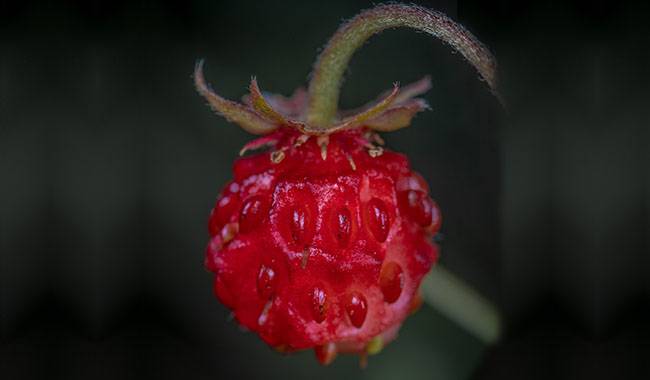
The edges of the leaves and the tops of the plants are curling to the bottom – this is a potassium deficiency. If the root-bearing layer of Raspberry soil is not supplemented with this element, the berries on the bush will be small, loose, and poor tasting. In addition, potassium deficiency can cause susceptibility to disease and reduce the plant’s resistance to high and low temperatures.
Fortunately, however, deficiencies of this element are rare (and mainly on light soils), so they are more easily avoided by fertilizing Raspberry with phosphorus and potash every other year or with annual grass ashes.
LEAF DISCOLORATION BETWEEN VEINS AT THE BASE OF RASPBERRY STEMS
Leaf discoloration between the veins at the base of the shoot is a sure sign of manganese deficiency. It starts at the edge of the leaf and develops on the inside of the leaf. Severe manganese deficiency can lead to tissue necrosis.
What to do? Treat the leaves of the plant with a 2% solution of manganese chelate.
RASPBERRY LEAF CHLOROSIS
Leaf chlorosis (with green veins), including young shoots, is most often a sign of iron deficiency. The more iron deficiency there is, the lighter the leaves will be. In critical cases, the leaves may even fall off.
What to do? Treat Raspberry leaves with a 1% solution of iron chelate.
WILT OF ALL GREEN PARTS OF RASPBERRY
The wilting of all green parts of Raspberry may be a sign of water stagnation in the root zone of the plant. In this case, the flowers on them are not developed, and the berries are small and tasteless. Unless prompt action is taken, the shoots will wilt.
What can be done? Restore growing conditions favorable to Raspberry.
More Related Information About Planting & Growing Raspberry Plants




